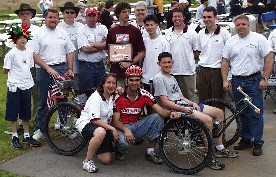Team
Buggy
Competition
Sponsors
That night, the entire team worked to finish the buggy and at 7:00am on Friday, we finally decided that we had to leave or else we wouldn't be able to make it to Alabama in time for the competition which began Saturday morning. We had finished the buggy, but the drivetrain was still having difficulties and one of the carbon fiber handlebars had worked itself loose from it's aluminum attachment point. So we loaded up the van and the seven of us who were going (Brad Crowley, Vince Luh, Stanley Song, Brett Lee, Chris Boitnott, Ruth Gonzalez, and Matt Siegler) headed off.
After we had all taken turns sleeping for several hours in the van, we began to brainstorm ways to fix the two problems we had been unable to deal with before we left. We came up with some solutions and decided that we needed to find a hardware store to buy some PVC piping, epoxy and some pipe clamps. Spotting a Lowe's hardware along the highway in central Virginia, we pulled off around 3:00pm on Friday afternoon and headed in to buy the supplies we needed. In the parking lot, we pulled the buggy out of the back of the van and worked for three hours implementing the solutions we'd come up with earlier. And to our great joy they worked! So the Cornell Moonbuggy drove under human power for the first time at 6:15pm on Friday in the back of a Lowe's parking lot in the middle of Virginia (there's a nice photo of this).
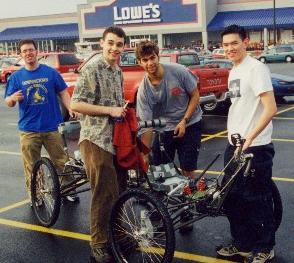 Climbing back into the van with spirits much lifted, we
finished up the drive to Huntsville. We arrived at our hotel
at 5:00am Saturday morning and worked out in the parking lot
till we could take advantage of the free continental
breakfast at 6:00 and then showered and headed to the Space
and Rocket Center to check in.
Climbing back into the van with spirits much lifted, we
finished up the drive to Huntsville. We arrived at our hotel
at 5:00am Saturday morning and worked out in the parking lot
till we could take advantage of the free continental
breakfast at 6:00 and then showered and headed to the Space
and Rocket Center to check in.We had a few modifications to make in the pit area that required a welder, so after we parked and unloaded, we assembled the buggy and drove it over. We were happily surprised to see that the pit crew was much the same as last year! We spent a LOT of time in the pit area last year (because we arrived with an uncompleted buggy) and got to know the folks that worked there pretty well. So when they saw our entry this year, they were very impressed!
Of the 31 Collegiate entries, we were 6th to run the course. So as the team made a few last minute adjustments to the buggy, the two drivers Chris and Ruth went to observe the track. Just as we were pulling the buggy out of the pit area, we heard our name announced to report to the starting line. There we disassembled the buggy to fit it into the 4'x4'x4' cube. There are stiff penalties for not fulfilling all these requirements, so we held our breaths as they measured. We had designed it to fit in the required volume, but had never actually tested to see if the completed buggy was small enough! Although it was very close, we just barely fit and were allowed to go onto the next pre-race check. Although there is no weight requirement, the buggy must be light enough for the two riders to carry it 20 feet. There is no time limit, they just have to be able to lift it together and carry it 20 feet. Our buggy weighs about 125 lbs (this is our best guess, we still haven't actually weighed it), so Chris and Ruth had no trouble carrying it. However, just then we noticed that the bolt that holds the right front wheel on was missing! So after a quick dash back to the van to get a new one, we replaced it. However, the judges decided that Chris and Ruth needed to perform the 20 foot carry again! I guess they though that bolt might be the straw that breaks the camel's back. Anyway, they were carrying it across the 20 feet for the second time (obviously with ease) when the small rod that connects the two halves together during assembly falls to the ground. Just in case that rod might make the difference, they make them carry it again! The third time was uneventful and we moved on to the final and most stressful pre-race check, the assembly.
The winner of the Moonbuggy race is decided based on who has the lowest total time. The total time is composed of the race time and the assembly time. So in a race where the difference between first and second place is often only a few seconds, the time to assemble a buggy is very important. For example, a team with an assembly time of 3 seconds has a great advantage over a team with an assembly time of 24 seconds… they can have a 20 second slower race time and still win the competition by 1 second. Although teams are given two runs of the course, they are only given one chance to assemble the buggy. Our buggy was relatively complex to assemble and our 58 second assembly time was largely due to the fact that Chris and Ruth had never actually put it together before! We were so rushed to get the buggy working that we never gave them a chance to practice putting it together. Although 58 seconds was slow in comparison with the winning teams, 2, 3 or even 8 minutes were not uncommon assembly times.
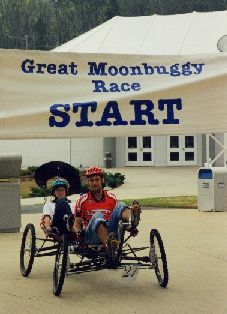 The first race appeared to run flawlessly with a time of 6:03.
It is pretty much guaranteed that if a buggy gets stuck on
an obstacle or hits a hay bale and is forced to back up,
they've already lost the race. Our first run wasn't terribly
fast, but it was steady. Keep in mind that this was the first
ever serious test of the Moonbuggy's suspension, steering and
drivetrain over rugged terrain. Bumps that large can easily
tear the steering away from the driver or even break wheels
or frame members. So we were very excited that we ended the
first run with a very respectable time and without requiring
any major repairs.
The first race appeared to run flawlessly with a time of 6:03.
It is pretty much guaranteed that if a buggy gets stuck on
an obstacle or hits a hay bale and is forced to back up,
they've already lost the race. Our first run wasn't terribly
fast, but it was steady. Keep in mind that this was the first
ever serious test of the Moonbuggy's suspension, steering and
drivetrain over rugged terrain. Bumps that large can easily
tear the steering away from the driver or even break wheels
or frame members. So we were very excited that we ended the
first run with a very respectable time and without requiring
any major repairs.After we settled down from our elated celebration, we set about questioning Chris and Ruth about how we could modify the buggy in the next 3 hours to help them make the next run faster. We decided that the steering was a bit too touchy. By adding some additional holes in our steering rotator, we gave Chris more leverage on the front wheels so he could more easily hold the buggy straight through the rough course. Also, Chris's front seat had a bit too much flex in it. When he pushed hard on the pedals, he drove himself into the seat back. Although we calculated the steel making up the seat back to be strong enough to not break, we had forgotten to calculate how much it would flex! So when he pedaled hard, his seat back interfered with Ruth's pedaling. Some quick modifications helped this problem as well. As it turned out in our hurry to complete the buggy, several of the tack welds that held the rear pedals in place had not been gone over a second time. So during Ruth's hard pedaling efforts, she had partially broken them free. A third trip to the pit area secured this as well. But perhaps the most significant problem was the loss of Chris's shifting capability. The mount that we had constructed for the front internal hub shifter didn't support it adequately enough. Consequently, when Chris pushed hard on the pedals, the shifter was free to rotate in it's mount. This unexpected motion broke a small metal ring that transmits the driver's input from the shifter mounted on the handle bar into the shifting mechanism itself. This meant that although the drivetrain still worked, the front pedals were permanently stuck in 1st gear. Although Chris reported that this wouldn't be too much of a problem (since he had spent most of his time in 1st gear anyhow) it would affect our top speed during the straight-aways and downhill sections.
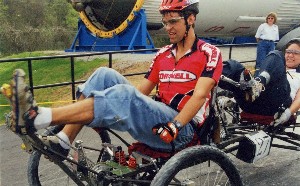 With one respectable run of the course under our belts we
decided to let Chris and Ruth push the buggy a little harder
for the second run. Between their efforts and our
modifications to the buggy, we shaved off almost a minute.
The second run took 5:07. Combined with our assembly time,
our total time now came to 6:05. This put us in fourth place
for the competition out of the 31 buggies that competed.
Pittsburgh State University placed first, University of New
Hampshire placed second, and The College of New Jersey (last
year's winners) placed third.
With one respectable run of the course under our belts we
decided to let Chris and Ruth push the buggy a little harder
for the second run. Between their efforts and our
modifications to the buggy, we shaved off almost a minute.
The second run took 5:07. Combined with our assembly time,
our total time now came to 6:05. This put us in fourth place
for the competition out of the 31 buggies that competed.
Pittsburgh State University placed first, University of New
Hampshire placed second, and The College of New Jersey (last
year's winners) placed third.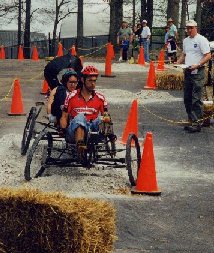 It's interesting to note that we had the third fastest race
time. It was our long assembly that put us into fourth place.
This aside, we all were extremely happy with our
performance. We all believed that with a little more time for
fine tuning and a streamlined assembly, this same buggy could
have been a serious contender for 1st place (4:36). As a nice
ending to the day, we were presented with the Pit Crew Award
by our friends there. This award is given to the team who
best struggles though and surmounts the technical difficulties
during the competition that all teams face.
It's interesting to note that we had the third fastest race
time. It was our long assembly that put us into fourth place.
This aside, we all were extremely happy with our
performance. We all believed that with a little more time for
fine tuning and a streamlined assembly, this same buggy could
have been a serious contender for 1st place (4:36). As a nice
ending to the day, we were presented with the Pit Crew Award
by our friends there. This award is given to the team who
best struggles though and surmounts the technical difficulties
during the competition that all teams face.Although it's still very early, we've already began discussing plans for next year. Because the '01 buggy performed so well, we'd like to have several team members dedicate their time next year to some more scientific testing and refinement of its performance. With our success this year, we hope to have enough team members and funding to enter two buggies in the '02 competition, one a ground up effort and the other an improvement and continuation of this year's project.
